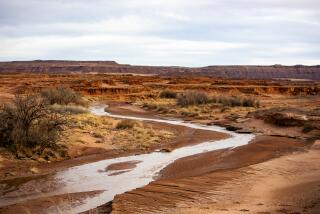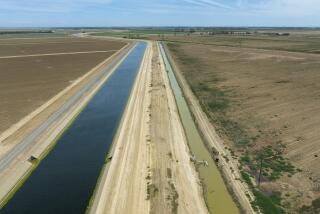Earliest known irrigation system unearthed in Arizona
- Share via
Archaeologists preparing for the expansion of a Tucson wastewater treatment facility have discovered the remains of the earliest known irrigation system in the Southwest, a farming community that dates to at least 1200 BC.
That predates the well-known and much more sophisticated Hohokam tribe’s canal system, which crisscrossed what is now Phoenix, by 1,200 years. The find suggests that the people who inhabited the region began with relatively simple irrigation systems and built up to more complex projects as the climate became hotter and drier.
“These are not the earliest canals known in southern Arizona, but they are the most extensive and sophisticated engineering [from the period] that we have identified to date,” said archaeologist James M. Vint of Desert Archaeology Inc. in Tucson.
The site, called Las Capas, or “The Layers,” sits at the confluence of Canada del Oro, Rillito Creek and the Santa Cruz River. The name derives from the repeated layers of silt that buried the site until nothing was visible from the surface.
Researchers already knew that the site had been inhabited during what is known as the San Pedro phase of the Early Agriculture Period in the Southwest. Earlier work at the plant had revealed traces of pit houses, fire pits and ditches. What is believed to be the main dwelling is now buried under the adjacent Interstate 10.
Vint led a team of 30 archaeologists who explored the site in compliance with state laws before a planned expansion of the Ina Road facility. “We put in a mile and a half of backhoe trenches and did archaeology in all those trenches,” he said in a telephone interview. “That tells us this is a very expansive site.”
They identified two main canals bringing water from the Santa Cruz River and feeding it into eight distribution canals, all now buried 3 to 7 feet. The system could have irrigated 60 to 100 acres, he estimated. The primary crops were maize, which was introduced into the area before 2100 BC, and an herb known as amaranth.
Vint estimated that the village at the site supported 80 to 150 people. Their cultural identity is unknown, although they probably originated in Mexico and moved across what is now the border. Pottery was not yet produced in the region, but Vint’s team found stone and cutting tools, grinding stones, antler pieces for making stone tools, and awls for basketry.
“We can’t say anything about their culture,” said archaeologist Stephanie Whittlesey of SWCA Environmental Consultants in Tucson, who was not involved in the research. “They had no writing and no recorded documents, so the only thing we have to go on is what they left behind, which isn’t a lot.”
The evidence indicates that the region suffered a huge flood about 800 BC, which buried the canal system. “There is some evidence that they tried getting it going again, but apparently that didn’t work,” Vint said. They cleaned out some sections, “but they never brought it back to full scale.”
Vint is not sure what happened to the inhabitants, but most likely, he said, they simply moved upriver to other villages.
--
More to Read
Sign up for Essential California
The most important California stories and recommendations in your inbox every morning.
You may occasionally receive promotional content from the Los Angeles Times.










